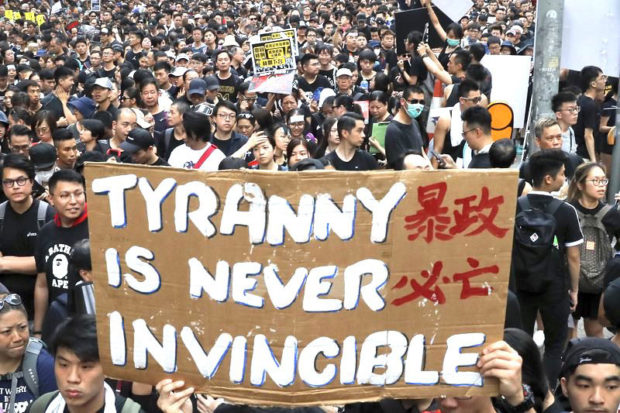
Tens of thousands of protesters carry posters and banners march through the streets as they continue to protest an extradition bill, Sunday, June 16, 2019, in Hong Kong. Hong Kong residents were gathering Sunday for another mass protest over an unpopular extradition bill that has highlighted the territory’s apprehension about relations with mainland China. AP PHOTO
NEW YORK—The brave souls of Hong Kong continue to buck the Beijing-backed city government, led by Chief Executive Carrie Lam, tempting the mainland to unleash its troops and suppress the pro-democracy movement violently. How long will the dragon hold its fire? Already, one teenaged protester has been shot by a policeman, thankfully not fatally, but this escalation does not bode well.
The initial spur for the protest was a bill that would have allowed the extradition to the mainland of suspects in criminal cases filed in Hong Kong—a law that would in effect have meant that trumped-up charges of criminality could be lodged against political activists who could then be tried by the Chinese courts, controlled by the Chinese Communist Party. The proposed legislation was withdrawn but that hasn’t stopped the pro-democracy movement, which now demands, among others, that there be an independent investigation into police abuses in handling the protests, the resignation of Lam, and significant electoral reforms.
Foretelling these protests was the 2014 student-led Umbrella Movement. Today’s street battles aren’t just a reprise of 2014, but a deeper, better organized, and wide-spread movement that, in this age of social media, does not have (nor does it need) a centralized leadership. The fear of Hong Kongers is that the autonomy granted their city under the hand-over agreement with the United Kingdom, to last for 50 years and referred to as “one country, two systems,” is being undermined and likely be tossed into the dustbin of history way before 2047.
Hong Kong has never been officially a sister city of Manila, but for all intents and purposes it is. It has always provided expatriate Filipinos political refuge, entertainment, shopping—and employment.
There are an estimated 200,000 expatriate Filipinos living in the former Crown Colony, the vast majority female domestic helpers, in the unending exodus of those who seek better lives abroad. Among the expats are also white-collar professionals, working mainly in the financial services sector, and a dwindling community of jazz musicians.
For a brief period of time, it was Manila that provided employment opportunities for Hong Kongers, especially for amahs, recruited by Filipino families to care for their children and run their households. To have an amah was a status symbol back then. I imagine a Hong Kong family with a Pinay helper is similarly placed in that city’s social hierarchy.
But the ties between the two cities are not just economic, but historical as well.
In December of 1891, José Rizal, having decided to return to Las Islas Filipinas from Europe, first stopped in Hong Kong, to get a sense of what was going on in the homeland before setting foot on it. In his six months there, he practiced as an ophthalmologist, and had his family visit. A plaque marks the site where he lived, on D’Aguilar Street, at Rednaxela Terrace, the Mid-Levels district.
There he began conceptualizing what was to take shape in Manila as La Liga Filipina, a reformist society advocating for Filipinos to be given the same rights as Spaniards but still envisioning the archipelago as part of Spain. This would give the friars the excuse they needed to silence him, even though he and his fellow Propagandists had been openly championing this very idea in Spain.
At the same time, Rizal had the rather utopian idea of establishing a Filipino settlement in North Borneo, where his family and approximately 300 families from Calamba, his hometown, could settle, away from the avaricious and tyrannical Dominican friars, who controlled the estates that his family had leased and farmed for decades.
The British, though initially receptive, in the end nixed the idea. Nor would the Spanish have agreed to having a colony of dissatisfied Indios just outside its southern borders.
During the 1896 revolution against Spain, following the Treaty of Biak-na-Bato in December of 1897—a truce between the two opposing forces—Emilio Aguinaldo and most of his Cabinet sailed to Hong Kong in self-imposed albeit temporary exile. In April of 1898, the Spanish-American war erupted.
The U.S. Pacific fleet, stationed in Hong Kong, under the command of Commodore George Dewey was ordered to sail to Manila to engage the Spanish, where on May 1, it decimated the decrepit Spanish navy. Subsequently, one of Dewey’s ships transported Aguinaldo back to Philippine shores. (To be continued)
@ copyright L.H. Francia

